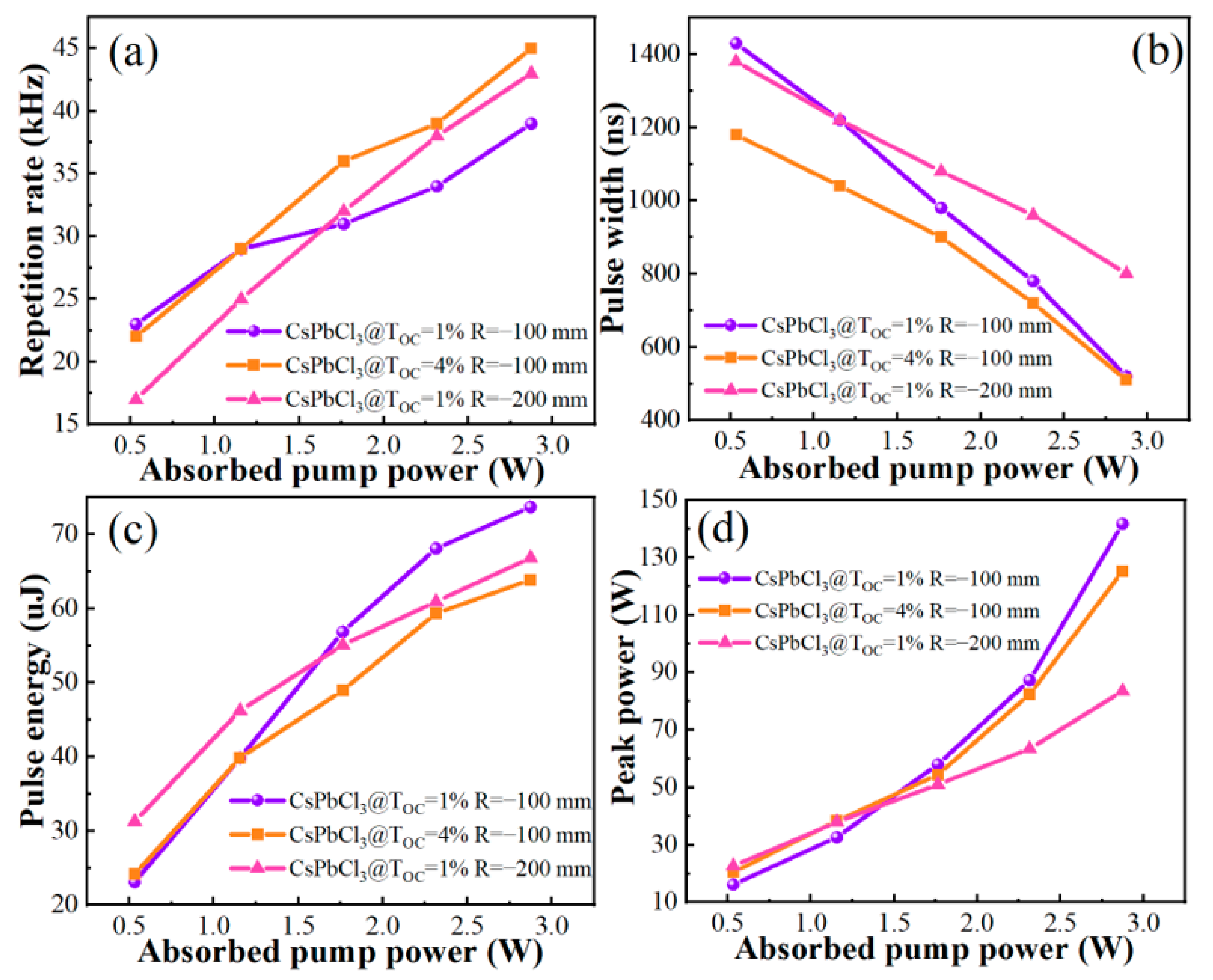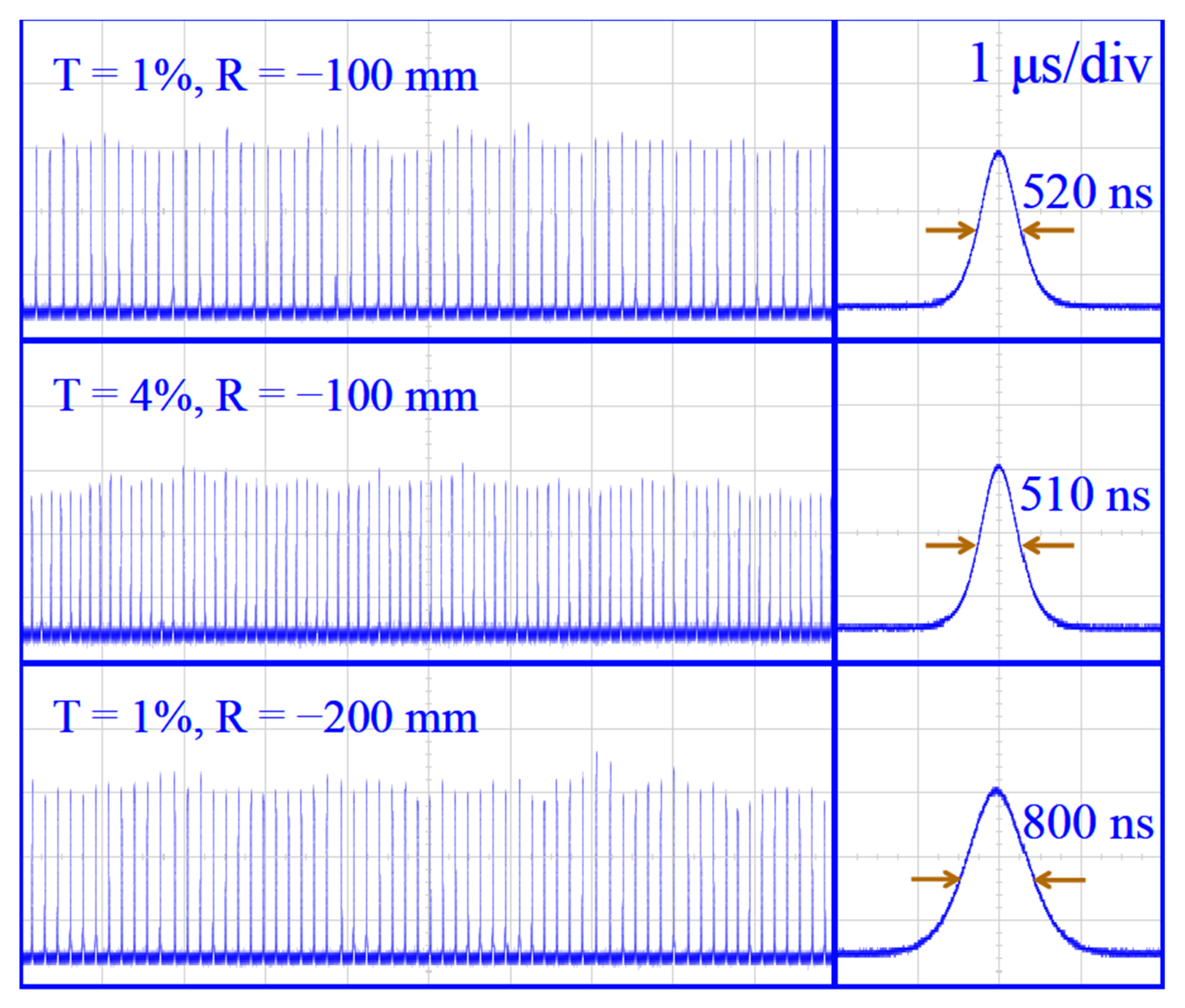Mid-Infrared Dual-Wavelength Passively Q-Switched Er: SrF2 Laser by CsPbCl3 Quantum Dots Absorber
Abstract
:1. Introduction
2. Device Characterization and Experiment
3. Results and Discussion
4. Conclusions
Author Contributions
Funding
Institutional Review Board Statement
Informed Consent Statement
Data Availability Statement
Acknowledgments
Conflicts of Interest
References
- Walsh, J.T.; Flotte, T.J.; Deutsch, T.F. Er: YAG laser ablation of tissue: Effect of pulse duration and tissue type on thermal damage. Lasers Surg. Med. 1989, 9, 314–326. [Google Scholar] [CrossRef] [PubMed]
- Hugi, A.; Villares, G.; Blaser, S.; Liu, H.C.; Faist, J. Mid-infrared frequency comb based on a quantum cascade laser. Nature 2012, 492, 229–233. [Google Scholar] [CrossRef] [PubMed]
- Antipov, S.; Hudson, D.D.; Fuerbach, A.; Jackson, S.D. High-power mid-infrared femtosecond fiber laser in the water vapor transmission window. Optica 2016, 3, 1373–1376. [Google Scholar] [CrossRef]
- Schaar, J.E.; Vodopyanov, K.L.; Fejer, M.M. Intracavity terahertz-wave generation in a synchronously pumped optical parametric oscillator using quasi-phase-matched GaAs. Opt. Lett. 2007, 32, 1284–1286. [Google Scholar] [CrossRef]
- Schellr, M.; Yarborough, J.M.; Moloncy, J.V.; Fallahi, M.; Koch, M.; Koch, S.W. Room temperature continuous wave milliwatt terahertz source. Opt. Express 2010, 18, 27112–27117. [Google Scholar] [CrossRef]
- Kiessling, J.; Breunig, I.; Schunemann, P.G.; Buse, K.; Vodopyanov, K.L. High power and spectral purity continuous-wave photonic THz source tunable from 1 to 4.5 THz for nonlinear molecular spectroscopy. New J. Phys. 2013, 15, 105014–105025. [Google Scholar] [CrossRef]
- Creeden, D.; McCarthy, J.C.; Ketteridge, P.A.; Southward, T.; Schunemann, P.G.; Komiak, J.J.; Dove, W.; Chicklis, E.P. Compact Fiber-Pumped Terahertz Source Based on Difference Frequency Mixing in ZGP. IEEE J. Sel. Top. Quantum Electron. 2007, 13, 732–737. [Google Scholar] [CrossRef]
- Wang, Y.X.; Liu, W.X.; Zhang, Z.H.; Strzep, A.; Liu, J.; Chen, Z.Q.; Ma, F.K.; Su, L.B. Laser-diode-pumped Tm:SrF2 single crystal for high efficiency CW laser operation at ~2 µm. Opt. Lett. 2022, 47, 1117–1120. [Google Scholar] [CrossRef]
- Guan, X.; Zhan, L.; Zhu, Z.; Xu, B.; Xu, H.; Cai, Z.; Cai, W.; Xu, X.; Zhang, J.; Xu, J. Continuous-wave and chemical vapor deposition graphene-based passively Q-switched Er:Y2O3 ceramic lasers at 2.7 μm. Appl. Opt. 2018, 57, 371. [Google Scholar] [CrossRef]
- Li, C.; Liu, J.; Jiang, S.; Xu, S.; Ma, W.; Wang, J.; Xu, X.; Su, L. 2.8 μm passively Q-switched Er: CaF2 diode-pumped laser. Opt. Mater. Express 2016, 6, 1570. [Google Scholar] [CrossRef]
- Fang, Z.; Sun, D.; Luo, J.; Zhang, H.; Zhao, X.; Quan, C.; Hu, L.; Cheng, M.; Zhang, Q.; Yin, S. Thermal analysis and laser performance of a GYSGG/Cr, Er, Pr: GYSGG composite laser crystal operated at 2.79 μm. Opt. Express 2017, 25, 21349–21357. [Google Scholar] [CrossRef] [PubMed]
- Ma, W.; Qian, X.; Wang, J.; Liu, J.; Fan, X.; Liu, J.; Su, L.; Xu, J. Highly efficient dual-wavelength mid-infrared CW Laser in diode end-pumped Er: SrF2 single crystals. Sci. Rep. 2016, 6, 36635. [Google Scholar] [CrossRef] [PubMed]
- Liu., J.; Liu, J.; Yang, J.; Ma, W.; Wu, Q.; Su, L. Efficient mid-infrared laser under different excitation pump wavelengths. Opt. Lett. 2017, 42, 3908–3911. [Google Scholar] [CrossRef] [PubMed]
- Liu, J.; Feng, X.; Fan, X.; Zhang, Z.; Zhang, B.; Liu, J.; Su, L. Efficient continuous-wave and passive Q-switched mode-locked Er3+: CaF2-SrF2 lasers in the mid-infrared region. Opt. Lett. 2018, 43, 2418–2421. [Google Scholar] [CrossRef]
- Nie, H.; Shi, B.; Xia, H.; Hu, J.; Zhang, B.; Yang, K.; He, J. High-repetition-rate kHz electro-optically Q-switched Ho, Pr: YLF 2.9 μm bulk laser. Opt. Express 2018, 26, 33671–33677. [Google Scholar] [CrossRef]
- Wang, L.; Wang, J.; Yang, J.; Wu, X.; Sun, D.; Yin, S.; Jiang, H.; Wang, J.; Xu, C. 2.79 μm high peak power LGS electro-optically Q-switched Cr, Er: YSGG laser. Opt. Lett. 2013, 38, 2150–2152. [Google Scholar] [CrossRef]
- Pushkin, A.V.; Mazur, M.M.; Sirotkin, A.A.; Firsov, V.V.; Potemkin, F.V. Powerful 3μm lasers acousto-optically Q-switched with KYW and KGW crystals. Opt. Lett. 2019, 44, 4837–4840. [Google Scholar] [CrossRef]
- Duan, X.; Chen, G.; Shen, Y.; Zheng, L.; Su, L. High-Power Cotinuous-Wave and Acousto-Optical Q-Switched Ho:(Sc0.5Y0.5)2SiO5 Laser Pumped by Laser Diode. Chin. Phys. Lett. 2019, 36, 064201. [Google Scholar] [CrossRef]
- Liu, J.; Zong, M.; Wang, D.; Zhang, Z.; Su, L. Acousto-optic Q-switched Er:CaF2-SrF2 laser at 2.73 μm. Infrared Phys. Technol. 2021, 116, 103758. [Google Scholar] [CrossRef]
- Liu, J.; Fan, M.; Su, L.; Jiang, D.; Ma, F.; Zhang, Q.; Xu, J. Laser performance of diode-pumped Nd, Y-codoped CaF2-SrF2 mixed crystal. Laser Phys. 2014, 24, 035802. [Google Scholar] [CrossRef]
- Novoselov, K.S.; Geim, A.K.; Morozov, S.V.; Jiang, D.; Zhang, Y.; Dubonos, S.V.; Grigorieva, I.V.; Firsov, A.A. Electric Field Effect in Atomically Thin Carbon Films. Science 2004, 306, 666–669. [Google Scholar] [CrossRef] [PubMed]
- Zhang, H.; Bao, Q.; Tang, D.; Zhao, L.; Loh, K. Large energy soliton erbrium-doped fiber laser with a graphene-polymer composite mode locker. Appl. Phys. Lett. 2009, 95, 141103. [Google Scholar] [CrossRef]
- Li, L.; Yu, Y.; Ye, G.J.; Ge, Q.; Ou, X.; Wu, H.; Feng, D.; Chen, X.; Zhang, Y. Black phosphorus field-effect transistors. Nat. Nanotechnol. 2014, 9, 372–377. [Google Scholar] [CrossRef] [PubMed]
- Huang, B.; Yi, J.; Jiang, G.; Miao, L.; Hu, W.; Zhao, C.; Wen, S. Passively Q-switched vectorial fiber laser modulated by hybrid organic-inorganic perovskites. Opt. Mater. Express 2017, 7, 1220–1227. [Google Scholar] [CrossRef]
- Bao, X.; Mu, H.; Chen, Y.; Li, P.; Li, L.; Li, J.; Khan, Q.; Zhang, Y.; Zhang, H.; Bao, Q. Ytterbium-doped fiber laser passively mode locked by evanescent field interaction with CH3NH3SnI3 perovskite saturable absorber. J. Phys. D Appl. Phys. 2018, 51, 375106. [Google Scholar] [CrossRef]
- Li, P.; Yao, C.; Yang, T.; Wang, Z.; Lin, H.; Xu, Y.; Li, L.; Mu, H.; Shivananju, B.N.; Zhang, Y.; et al. Two-Dimensional CH3NH3PbI3 Perovskite Nanosheets for Ultrafast Pulsed Fiber Lasers. ACS Appl. Mater. Inter. 2017, 9, 12759–12765. [Google Scholar] [CrossRef]
- Kim, K.K.; Hsu, A.; Jia, X.; Kim, S.M.; Shi, Y.; Hofmann, M.; Nezich, D.; Rodriguez-Nieva, J.F.; Dresselhaus, M.; Palacios, T.; et al. Synthesis of monolayer hexagonal boron nitride on Cu foil using chemical vapor deposition. Nano Lett. 2012, 12, 161–166. [Google Scholar] [CrossRef]
- Liu, H.; Luo, A.; Wang, F.; Tang, R.; Liu, M.; Luo, Z.C.; Xu, W.; Zhao, C.; Zhang, H. Femtosecond pulse erbium-doped fiber laser by a few-layer MoS2 saturable absorber. Opt. Lett. 2014, 39, 4591–4594. [Google Scholar] [CrossRef]
- Low, T.; Roldán, R.; Wang, H.; Xia, F.; Avouris, P.; Moreno, L.M.; Guinea, F. Plasmons and screening in monolayer and multilayer black phosphorus. Phys. Rev. Lett. 2014, 113, 106802. [Google Scholar] [CrossRef]
- Kocnig, S.P.; Doganov, R.A.; Schmidt, H.; Castro Ncto, A.H.; OEzyilmaz, B. Electric field effect in ultrathin black phosphorus. Appl. Phys. Lett. 2014, 104, 103106. [Google Scholar]
- Xia, F.; Wang, H.; Jia, Y. Rediscovering black phosphorus as an anisotropic 2D material for optoelectronics and electronics. Nat. Commun. 2014, 5, 4458. [Google Scholar] [CrossRef] [PubMed] [Green Version]
- Ma, J.; Lu, S.; Guo, Z.; Xu, X.; Zhang, H.; Tang, D.; Fan, D. Few-layer black phosphorus based saturable absorber mirror for pulsed solid-state lasers. Opt. Express 2015, 23, 22613–22618. [Google Scholar] [CrossRef]
- Yan, Z.; Hu, Z.; Yue, L.; Xu, J.; Tang, X.; Tang, Y. CsPbBr3 nanocrystal saturable absorber for mode-locking ytterbium fiber laser. Appl. Phys. Lett. 2016, 108, 831. [Google Scholar]
- Mushtaq, A.; Kushavah, D.; Ghosh, S.; Pal, S.K. Nonlinear optical properties of benzylamine lead(II) bromide perovskite microdisks in femtosecond regime. Appl. Phys. Lett. 2019, 114, 051902. [Google Scholar] [CrossRef]
- Xu, Z.; Chen, T.; Zhang, D.; Zheng, G.; Wu, J.; Yan, J.; Liu, X.; Qiu., J. Linear and nonlinear optical characteristics of CsPbBr3 perovskite quantum dots-doped borosilicate glasses. J. Eur. Ceram. Soc. 2021, 41, 729–734. [Google Scholar] [CrossRef]
- Liu, B.; Guo, L.; Chen, W.W.; Tang, X.S.; Gao, C.; Cao, Y.L.; Li, Y.J.; Zhu, T. 1.6 μm dissipative soliton fiber laser mode-locked by cesium lead halide perovskite quantum dots. Opt. Express 2018, 26, 7155–7162. [Google Scholar] [CrossRef]
- Jiang, G.; Miao, L.; Yi, J.; Huang, B.; Peng, W.; Zou, Y.; Huang, H.; Hu, W.; Zhao, C.; Wen, S. Ultrafast pulse generation from erbium-doped fiber laser modulated by hybrid organic-inorganic halide perovskites. Appl. Phys. Lett. 2017, 110, 161111. [Google Scholar] [CrossRef]
- Li, J.; Dong, H.; Xu, B.; Zhang, S.; Cao, Z.; Wang, J.; Zhang, L. CsPbBr3 perovskite quantum dots: Saturable absorption properties and passively Q-switched visible lasers. Photonics Res. 2017, 5, 457–460. [Google Scholar] [CrossRef]
- Zhang, R.; Fan, J.; Zhang, X.; Yu, H.; Zhang, H.; Mai, Y.; Xu, T.; Wang, J.; Snaith, H.J. Nonlinear Optical Response of Organic-Inorganic Halide Perovskites. ACS Photonics 2016, 3, 371–377. [Google Scholar] [CrossRef]
- Otero-Martínez, C.; García-Lojo, D.; Pastoriza-Santos, I.; Pérez-Juste, J.; Polavarapu, L. Dimensionality Control of Inorganic and Hybrid Perovskite Nanocrystals by Reaction Temperature: From No-Confinement to 3D and 1D Quantum Confinement. Angew. Chem. Int. Ed. Engl. 2021, 60, 26677–26684. [Google Scholar] [CrossRef]
- Sheik-Bahae, M.; Said, A.A. Sensitive measurement of optical nonlinearities using a single beam. IEEE J. Quantum Electron. 1990, 26, 760–769. [Google Scholar] [CrossRef]
- Lin, M.; Peng, Q.; Hou, W.; Fan, X.; Liu, J. 1.3 μm Q-switched solid-state laser based on few-layer ReS2 saturable absorber. Opt. Laser Technol. 2019, 109, 90–93. [Google Scholar] [CrossRef]
- Liu, J.; Liu, J.; Guo, Z.; Zhang, H.; Ma, W.; Wang, J.; Su, L. Dual-wavelength Q-switched Er: SrF2 laser with a black phosphorus absorber in the mid-infrared region. Opt. Express 2016, 24, 30289. [Google Scholar] [CrossRef] [PubMed]
- Kong, L.C.; Xie, G.Q.; Yuan, P.; Qian, L.J.; Wang, S.X.; Yu, H.H.; Zhang, H.J. Passive Q-Switching and Q-Switched Mode-Locking Operations of 2 μm Tm: CLNGG Laser with MoS2 Saturable Absorber Mirror. Photonics Res. 2015, 3, A47–A50. [Google Scholar] [CrossRef] [Green Version]





Publisher’s Note: MDPI stays neutral with regard to jurisdictional claims in published maps and institutional affiliations. |
© 2022 by the authors. Licensee MDPI, Basel, Switzerland. This article is an open access article distributed under the terms and conditions of the Creative Commons Attribution (CC BY) license (https://creativecommons.org/licenses/by/4.0/).
Share and Cite
Guo, L.; Wang, M.; Zhang, Y.; Zhang, S.; Zhong, K.; Zhao, Q.; Teng, L.; Wang, X.; Yao, J. Mid-Infrared Dual-Wavelength Passively Q-Switched Er: SrF2 Laser by CsPbCl3 Quantum Dots Absorber. Crystals 2022, 12, 1265. https://doi.org/10.3390/cryst12091265
Guo L, Wang M, Zhang Y, Zhang S, Zhong K, Zhao Q, Teng L, Wang X, Yao J. Mid-Infrared Dual-Wavelength Passively Q-Switched Er: SrF2 Laser by CsPbCl3 Quantum Dots Absorber. Crystals. 2022; 12(9):1265. https://doi.org/10.3390/cryst12091265
Chicago/Turabian StyleGuo, Leilei, Maorong Wang, Yifan Zhang, Shuaiyi Zhang, Kai Zhong, Qiuling Zhao, Lihua Teng, Xia Wang, and Jianquan Yao. 2022. "Mid-Infrared Dual-Wavelength Passively Q-Switched Er: SrF2 Laser by CsPbCl3 Quantum Dots Absorber" Crystals 12, no. 9: 1265. https://doi.org/10.3390/cryst12091265





